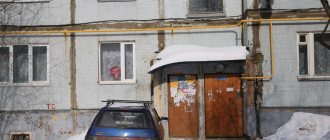A heating radiator in an apartment is the common property of the owners of premises in an apartment building
It is not uncommon for apartment owners, when a heating radiator in an apartment breaks and causes material damage to both themselves and the owners of downstream apartments when they are flooded with water, the question arises: Who is responsible for the proper maintenance and repair of these radiators - the owner himself or the management organization (HOA, Cooperative or other person responsible for the maintenance and repair of the common property of the apartment building)? Who is responsible for compensation for material damage caused by flooding of apartments?
The answer to this question is simple: if disconnecting devices (shut-off valves, shut-off valve) are installed on the branches from the heating risers to the heating radiator, then such a heating radiator is the property of the owner of the residential premises and the owner is responsible for its proper maintenance and timely repairs. If there is no such disconnecting device on the branches from the heating riser to the radiator, then the radiator is the common property of the apartment building, for the serviceability of which the management organization is responsible.
According to subparagraph 3 of paragraph 1 of Article 36 of the Housing Code of the Russian Federation, the owners of premises in an apartment building own, by the right of common shared ownership, the common property in the apartment building, including sanitary and other equipment located in this building outside or inside the premises and serving more one room.
In accordance with paragraph 6 of the Rules for the maintenance of common property in an apartment building, approved by Decree of the Government of the Russian Federation dated August 13, 2006 No. 491 (hereinafter referred to as the Rules), the common property includes an intra-house heating system, consisting of risers, heating elements, regulating and shut-off fittings, collective (common house) heat energy metering devices, as well as other equipment located on these networks.
In the letter of the Ministry of Construction of Russia dated April 1, 2021 No. 9506-ACh/04 “On the issue of classifying the heating elements of the heating system located inside the premises of apartment buildings as the common property of the owners of the premises of apartment buildings” it is stated that the heating elements of the heating system (radiators), which serve more than one residential premises, including those that do not have shut-off devices (shut-off valves) located on branches from the risers of the intra-building heating system located inside the apartments, are included in the common property of the owners of the premises in an apartment building.
Explanations on this application of clause 6 of the Rules and on the classification of radiators located inside apartments as the common property of an apartment building are given, in particular, in Letter of the Ministry of Regional Development of the Russian Federation dated September 4, 2007 No. 16273-SK/07 “On the composition of common property in an apartment building."
The intra-house heating system is a set of risers, heating elements, control and shut-off valves, a collective (common house) heat energy meter, as well as other equipment located on these networks.
Within the meaning of the specified norms of the housing legislation of the Russian Federation, the Rules for the maintenance of common property in an apartment building, equipment located in an apartment building can be classified as common property only if it serves more than one premises.
Consequently, such property includes only heating elements of the heating system (radiators) that serve more than one apartment.
According to the position set forth in the Decision of the Supreme Court of the Russian Federation dated September 22, 2009 in case No. GKPI09-725, the common property of premises owners in an apartment building includes only those heating elements of the heating system (radiators) that serve more than one apartment (located behind outside apartments on stairwells, in basements, etc.). The heating elements of the heating system (radiators) located in the apartments, having shut-off devices located on branches from the risers of the intra-house heating system, serve one apartment and can be dismantled by the owner after obtaining permission to renovate the residential premises in the prescribed manner
When classifying heating elements of a heating system (radiators) as common property in an apartment building, a significant circumstance is the presence or absence of disconnecting devices on such elements.
Accordingly, the heating elements of the heating system (radiators) located in the apartments, having shut-off devices located on branches from the risers of the intra-house heating system, serve one apartment and can be dismantled by the owner after receiving permission to reconstruct the residential premises in the prescribed manner, are not included in the common property .
In the absence of shut-off devices in front of the heating radiators in the apartment, the management organization is responsible for material damage and moral harm caused to the owners of the premises by flooding of apartments, due to the following.
Part 1 of Article 161 of the Housing Code of the Russian Federation stipulates that the management of an apartment building must ensure favorable and safe living conditions for citizens and proper maintenance of common property in the apartment building.
Proper maintenance of the common property of the owners of premises in an apartment building must be carried out in accordance with the requirements of the legislation of the Russian Federation, including on the protection of consumer rights, and must ensure compliance with the requirements for the reliability and safety of an apartment building; safety of life, health and property of citizens; compliance with the rights and legitimate interests of the owners of premises in an apartment building, as well as other persons (Part 1.1 of this article).
When managing an apartment building by a management organization, it is responsible to the owners of the premises in the apartment building for the provision of all services and (or) performance of work that ensure the proper maintenance of the common property in this building and the quality of which must meet the requirements of technical regulations and maintenance rules established by the Government of the Russian Federation common property in an apartment building, for the provision of utility services depending on the level of improvement of the building, the quality of which must meet the requirements of the rules established by the Government of the Russian Federation for the provision, suspension and limitation of the provision of utility services to owners and users of premises in apartment buildings and residential buildings (Part 2.3 of this same articles).
As follows from paragraph 10 of the Rules, common property must be maintained in accordance with the requirements of the legislation of the Russian Federation (including on the sanitary and epidemiological welfare of the population, technical regulation, consumer protection) in a condition that ensures compliance with the reliability and safety characteristics of an apartment building; safety for the life and health of citizens, safety of property of individuals or legal entities, state, municipal and other property, etc.
Proper maintenance of the common property of an apartment building is ensured by the owners of the premises by concluding a management agreement for the apartment building with the management organization in accordance with Part 5 of Article 161 and Article 162 of the Housing Code of the Russian Federation (clause 16 of the Rules).
Management organizations that provide services and perform work during the direct management of an apartment building are responsible to the owners of the premises for violation of their obligations and are responsible for the proper maintenance of common property in accordance with the legislation of the Russian Federation and the agreement (clause 42 of the Rules).
A selection of judicial practice of the Supreme Court of the Russian Federation:
Decision of the Supreme Court of the Russian Federation dated September 22, 2009 in case No. GKPI09-725
Resolution of the Supreme Court of the Russian Federation dated June 6, 2016 in case No. 91-AD16-1
Determination of the judicial panel for civil cases of the Supreme Court of the Russian Federation dated 04/09/2019 in case No. 5-КГ18-321
Disputes about common property
Advokatskaya Gazeta is launching a socially oriented project. As part of the new section “AG-Expert,” lawyers explain complex legal issues for citizens who do not have a legal education.
Today, disputes about the rights to common property are not uncommon.
This publication is devoted to the issues of challenging and protecting the right of ownership of non-residential premises in an apartment building. The court considered the case of challenging the right of ownership of non-residential premises. S. filed a lawsuit against B. and the Administration of the Petrozavodsk District to challenge the agreement for the acquisition of non-residential premises in an apartment building and to recognize the rights of the defendants to this object as absent. In support of the claim, the presence in the disputed premises of technical and engineering equipment intended to serve the needs of the entire building is indicated, and the status of this object, which is actually the common property of an apartment building.
Subsequently, K. and TU Rosreestr were brought in as co-defendants, and the claim was supplemented with demands to challenge the completed transactions on the transfer of ownership with the recognition of this right of K. as absent and the exclusion of records about such rights of the defendants from the Unified State Register of Real Estate.
The court found that in April 2015, state registration of municipal property rights to non-residential premises located in an apartment building was carried out. Subsequently, this object was transferred under the contract to K., and the latter - under the contract to B., for which at the time of consideration of the dispute the ownership was registered.
It should be noted that the claims were based on the attribution of the disputed premises to the common property of the apartment building. Based on the results of the forensic examination, it was established that the disputed premises are the technical premises of a common building heating point with a heating (elevator) unit and the corridor room of the evacuation route, which is the vestibule of the entrance to the gas shelter.
The claim was partially satisfied. B.'s ownership of non-residential premises was recognized as absent. The rest of the claim was denied.
Legal regulation of common property The essence of disputes about the ownership of non-residential premises in an apartment building comes down to deciding whether it is the common property of the apartment building.
In accordance with Art. 290 of the Civil Code of the Russian Federation, the owners of apartments in an apartment building own, by right of common shared ownership, the common premises of the house, the supporting structures of the house, mechanical, electrical, sanitary and other equipment outside or inside the apartment that serves more than one apartment.
The provisions of the Housing Code of the Russian Federation have clarified the list of common property in an apartment building. By virtue of Art. 36 of the Housing Code of the Russian Federation, common property also includes premises in an apartment building that are not parts of apartments and are intended to serve more than one room in a given building, including inter-apartment landings, stairs, elevators, elevator and other shafts, corridors, technical floors, attics , basements in which there are utility lines, other equipment serving more than one room in a given house (technical basements), as well as roofs enclosing load-bearing and non-load-bearing structures of the house, mechanical, electrical, sanitary and other equipment. Other premises in an apartment building that do not belong to individual owners and are intended to meet the social and everyday needs of the owners of premises in this building, including premises intended for organizing their leisure time, cultural development, children's creativity, physical education and sports and similar events, also include to common property.
Federal Law No. 218-FZ of July 13, 2015 “On State Registration of Real Estate” stipulates that state registration of the emergence, transition, termination, restriction of the right to residential or non-residential premises in apartment buildings and the encumbrance of such premises is at the same time state registration of the emergence, transition , termination, limitation of the inextricably linked rights of common shared ownership of common property and encumbrances of such property. Accordingly, when registering ownership of at least one residential or non-residential premises in an apartment building, the owner also receives the right of common shared ownership of premises intended to serve more than one premises in a given building, that is, state registration of ownership of residential or non-residential premises is a legal act of recognition and confirmation by the state of the emergence of the rights of the owners of premises in an apartment building to common property.
Explanations of the higher courts Difficulties often arise with the attribution or non-attribution of disputed premises to the common property of an apartment building - usually basements and attics.
Explanations on this matter were given by the Supreme Court, which, in its Determination of January 26, 2021 No. 5-KG15-207, indicated that the legal regime of basement premises as belonging or not relating to common shared ownership should be determined on the date of privatization of the first apartment in the house.
This position was previously expressed by the Supreme Arbitration Court in the Resolution of the Presidium of the Supreme Arbitration Court of the Russian Federation dated January 22, 2013 No. 11401/12 in case No. A40-121855/09-23-810. The court indicated that if the basement premises on the date of the first privatization were independent real estate objects, the right of common shared ownership of the homeowners cannot arise, since the legal regime of these premises as objects of civil rights differs from the legal regime of service premises.
The courts include the following signs indicating the independent nature of the use of basement premises: the placement in them of special premises, bathrooms equipped with washbasins and toilets; the presence of separate exits from these premises, isolation of the premises from the entrances to the entrances of a residential building, etc. The independent nature of the use of premises may also be indicated by their rental to various organizations for commercial and administrative purposes.
Choosing a method of protecting property rights In some cases, as in the case discussed, owners demand recognition of the ownership rights to non-residential premises as absent. In others, they apply for recognition of the right of common shared ownership of non-residential premises.
The legislation of the Russian Federation has established the following main types of protection: a vindication claim (a claim for the recovery of property from someone else’s illegal possession), a negatory claim (a claim by the owner of the property to eliminate violations of his rights that are not related to deprivation of possession) and a claim for recognition of property rights.
As noted in the Resolution of the Plenum of the Armed Forces of the Russian Federation and the Plenum of the Supreme Arbitration Court of the Russian Federation dated April 29, 2010 No. 10/22 “On some issues arising in judicial practice when resolving disputes related to the protection of property rights and other property rights”, in cases where the record in the Unified State Register (currently the Unified State Register of Real Estate) violates the right of the plaintiff, which cannot be protected by recognizing the right or reclaiming property from someone else’s illegal possession (ownership of the same property is registered with different persons, ownership of movable property is registered as on real estate, the mortgage or other encumbrance has ceased), challenging the registered right or encumbrance can be carried out by filing a claim to declare the right or encumbrance absent.
When choosing a method of protecting your right, you should remember the application of statute of limitations. According to paragraph 57 of the said Resolution No. 10/22, the limitation period for claims challenging a registered right begins from the day when the person learned or should have learned about the corresponding entry in the Unified State Register. At the same time, an entry in the register about a right or encumbrance on real estate does not mean that from the date of its entry the person knew or should have known about the violation of the right.
At the same time, the limitation period does not apply to requirements expressly provided for in Art. 208 Civil Code of the Russian Federation. These include the demands of the owner or another possessor to eliminate violations of his rights, if these violations were not associated with deprivation of possession, including demands to recognize the right (encumbrance) as absent.
As follows from the Resolution of the Plenum of the Armed Forces of the Russian Federation dated September 29, 2015 No. 43 “On some issues related to the application of the provisions of the Civil Code of the Russian Federation on the limitation period”, the provisions on the non-extension of the limitation period to the claims of the owner or other possessor to eliminate violations of his right, even if these violations were not associated with deprivation of possession, they do not apply to claims that are not negatory (for example, to claims for the recovery of property from someone else’s illegal possession).
As for buyers of basement premises in an apartment building, it should be noted that in order to minimize and eliminate the risks of loss of rights, they need to pay attention to the legal regime of the purchased non-residential premises on the date of the first state registration of ownership of an apartment in the building. At the same time, the choice of method of protecting their rights in each specific case will be determined based on the requirements of the plaintiffs in disputes regarding non-residential premises in an apartment building. Thus, in the dispute we are considering, B. has the right to apply to the court with a claim to apply the consequences of the invalidity of a void transaction due to the fact that the non-residential premises belong to common property.





